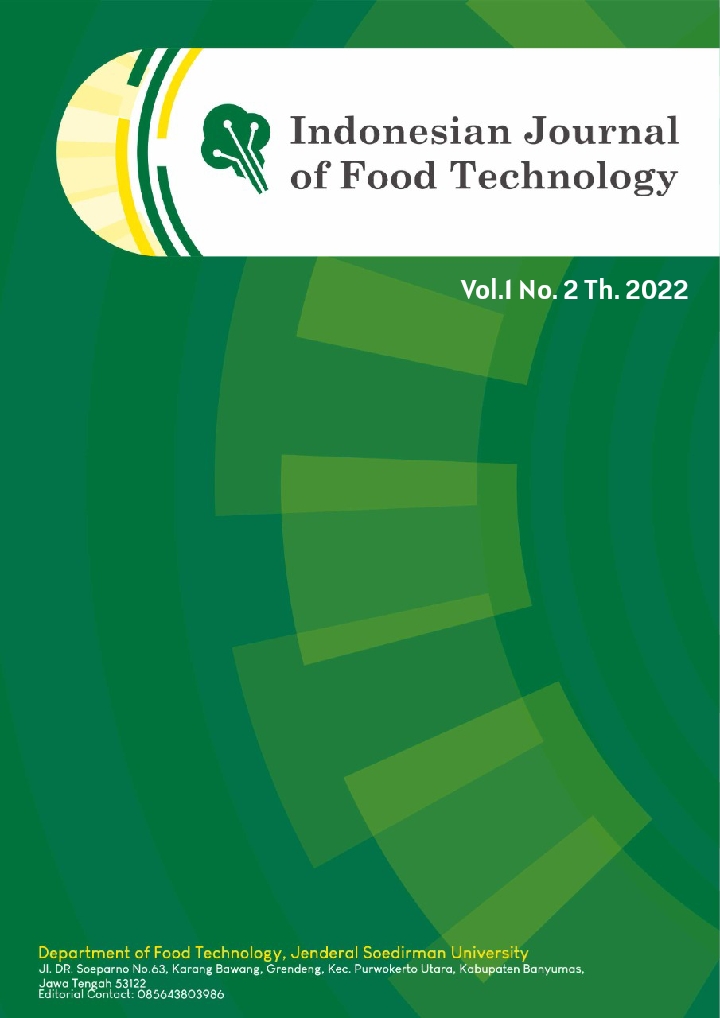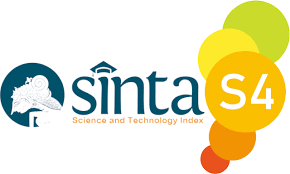Supplemental Porang Glucomannan Flour (Amorphophallus muelleri Blume) on Green Grass Jelly (Cyclea barbata L. Miers) Texture, Syneresis, and Moisture Content
Abstract
This study aims to determine the effect of adding porang glucomannan flour as a hydrocolloid on the texture, syneresis, and moisture content of green grass jelly gel (Cyclea barbata L. Miers). This research was conducted at Food & Agricultural Products Engineering Laboratory, and Chemistry & Biochemistry Laboratory of Semarang University in August 2022. Research experimental design that is used is one factor with completely randomized design and 4 replications. The treatment was adding porang glucomannan flour in a solution of green grass jelly extract consisting of: P0 = 0%, P1 = 0.5%, P2 = 1%, P3 = 1.5%, and P4 = 2% (percentage of porang flour in the solution of green grass jelly extract (w/v)). The observed parameters are texture, syneresis and moisture content. If there is a significant difference among the treatments, it will be tested with DMRT (Duncan Multiple Range Test). Based on the results of the study, it can be concluded that the addition of porang flour had a significant effect on the green grass jelly gel. In the texture aspect, the trend of increasing gel strength expressed in bloom load (g) in each treatment ranged from P0 = 6.63 gf to P4 = 31.13 gf, decreasing syneresis trend ranged from P0 = 38.35% to P4 = 0.0745%, and moisture content decreasing trend starting from P0 = 89.15% to P4 = 72.59% as the concentration of porang flour was added.
References
Ahmed, F., & Urooj, A. 2008. In vitro starch digestibility characteristics of Dioscorea alata tuber. World Journal of Dairy & Food Sciences, 3, 29-33.
Alamprese, C., & Mariotti, M. 2011. Effects of different milk substitutes on pasting, rheological and textural properties of puddings. LWT‐Food Science and Technology, 44, 2019–2025.
Almeida, N., L. Rakesh, et al., 2018. Viscoelastic properties of konjac glucomannan in the presence of salts. Journal of Thermal Analysis and Calorimetry 131(3): 2547–2553.
Alonso-Sande, M., Teijeiro-Osorio, D. Remunan-Lopez, C., & Alonso, M. J. 2009. Glucomannan, a promising polysaccharide for biopharmaceutical purposes. European Journal of Pharmaceutics and Biopharmaceutics, 72(2), 453–462.
Andarwulan N, Kusnandar F, Herawati D. 2011. Analisis Pangan. Jakarta (ID): Dian Ilmu.
AOAC. 2005. Official methods of analysis of the Association of Analytical Chemist. Virginia USA: Association of Official Analytical Chemist, Inc.
Arifin, M.A. 2001. Pengeringan keripik umbi iles-iles secara mekanik untuk meningkatkan mutu keripik iles. Teknologi Pasca Panen. Bogor: PPS-IPB.
Arkarapanthu, A., Chavasit, V., Sungpuag, P., & Phuphathanaphong, L. 2005. Gel extracted from Khruea-ma-noi (Cyclea barbata Miers) leaves: chemical composition and gelation properties. Journal of the Science of Food and Agriculture, 85(10), 1741–1749.
Atmaka, W., Prabawa, S., & Yudhistira, B. (2021). Pengaruh variasi konsentrasi kappa karagenan terhadap karakteristik fisik dan kimia gel cincau hijau (Cyclea barbata L. Miers). Warta Industri Hasil Pertanian, 38(1), 25-35.
Atmawati, T., Sugiyarto dan Sunarto. 2014. Keragaman cincau hijau (Cyclea barbata) berdasarkan karakter morfologi di kabupaten Purworejo. Elvivo 2(2): 73-81.
Bloom, Oscar T. 1925. US1540979A. United States of America.
Charoenrein, S., Tatirat, O., Rengsutthi, K., & Thongngam, M. 2011. Effect of konjac glucomannan on syneresis, textural properties and the microstructure of frozen rice starch gels. Carbohydrate Polymers, 83, 291-296.
De Padua, L., Bunyapratsara, dan Lemmens, R. 1999. Plant Resources of South East Asia. Medicinal and Poisonous Plants. PROSEA Foundation, Bogor. Halaman 21, 24, dan 30.
Dermoredjo S K, Azis M, Saputra Y H, Susilowati G and Sayaka B. 2021. IOP Conference Series: Earth and Environmental Science, 648, 1–10.
E. A. Suryana et al., 2022. IOP Conf. Ser.: Earth Environ. Sci. 985 012042.
Farida, Y dan Vanoria, I. 2008. Uji aktivitas antioksidan dari ekstrak daun cincau hijau (Cyclea barbata Miers), Cincau hitam (Mesona palustris B) dan cincau perdu (Premna parastica Blume) dengan metode peredaman radikal bebas DPPH. Farmasi 26(2):211-219.
Farmakope Indonesia Edisi V. 2014. Jakarta: Kementerian Kesehatan Republik Indonesia.
Funami, T., Y. Kataoka, T. Omoto, Y. Goto, I. Asai, and K. Nishinari. 2005. Effects of non-ionic polysaccharides on the gelatinization and retrogradation behavior of wheat starch. Food Hydrocolloids 19: 1–3.
Haghighi, M., & Rezaei, K. 2012. General Analytical Schemes for the Characterization of Pectin-Based Edible Gelled Systems. The Scientific World Journal, 2012, 1–12.
Handoko, K., Jamhari, T., & Yuniwati, H. 2019. Substitusi agar-agar dalam pembuatan Jelly Drink Cincau Hijau (Cyclea barbata) untuk menurunkan sineresis. Fast-Jurnal Sains dan Teknologi, 3(2).
Haryani Anwar S, Br. Ginting B M, Aisyah Y and Safriani N. 2017. Jurnal Teknologi Industri Pertanian 27, 76–88.
Hendek Ertop M, Atasoy R, Akın SS. Evaluation of taro (Colocasia Esculenta (L.) Schott) flour as a hydrocolloid on the physicochemical, rheological, and sensorial properties of milk pudding. J Food Process Preserv. 2019; 43:14103.
Impaprasert, R., Piyarat, S., Sophontanakij, N., Sakulnate, N., Paengkanya, S., Borompichaichartkul, C., & Srzednicki, G. 2017. Rehydration and textural properties of dried konjac noodles: Effect of alkaline and some gelling agents. Horticulturae, 3(1), 20.
Jimenez-Colmenero, F., S. Cofrades, et al. 2013. Konjac gel for use as potential fat analogue for healthier meat product development: Effect of chilled and frozen storage. Food Hydrocolloids 30(1): 351–357.
Kooiman, P. 1969. Cold water‐extractable pectin in cell walls of plant leaves. Journal of the Science of Food and Agriculture, 20(1), 18–20.
Koswara, Sutrisno. 2013. Teknik Pengolahan Umbi-Umbian: Pengolahan Umbi Talas. Modul. IPB. Bogor
Kusmardiyani, S., & Insanu, M. 2014. Effect of a glycosidic flavonol isolated from green grass jelly (Cyclea barbata Miers) leaves. Procedia Chemistry, 13, 194-197.
Lafarge, C., L. Journaux, et al. 2017. Trapping of carvacrol by konjac glucomannan-potato starch gels: Stability from macroscopic to microscopic scale, using image processing. Food Hydrocolloids 66: 216–226.
Lim, H. S., & Narsimhan, G. 2006. Pasting and rheological behavior of soy protein‐based pudding. LWT‐ Food Science and Technology, 39, 343–349.
Luo, X. G., P. He, et al. 2013. The mechanism of sodium hydroxide solution promoting the gelation of Konjac glucomannan (KGM). Food Hydrocolloids 30(1): 92–99.
Meng, F., Zheng, L., Wang, Y., Liang, Y., & Zhong, G. 2014. Preparation and properties of konjac glucomannan octenyl succinate modified by microwave method. Food Hydrocolloids, 38, 205–210.
Novidahlia, N., Rohmayanti, T., & Nurmilasari, Y. 2019. Karakteristik fisikokimia jelly drink daging semangka, albedo semangka, dan tomat dengan penambahan karagenan dan tepung glukomanan porang (Amorphophallus muelleri Blume). Jurnal Agroindustri Halal, 5(1), 057-066.
Nugent, A. P. 2005. Health properties of resistant starch. British Nutrition Foundation, Nutrition Bulletin.
Nurlela, J. 2015. The effect of leaf green grass jelly extract (Cyclea barbata L. Miers) to motility in mice balb/c male that exposed smoke. J Majority 4(4):58-64.
Official Journal of the European Union. 2012. Commission regulation (EU) No 231/2012 of 9 March 2012 laying down specifications for food additives listed in Annexes II and III to Regulation (EC) No 1333/2008 of the European Parliament and of the Council.
Ramdani, Baiq Kurnia. 2018. Pengaruh Konsentrasi Tepung glukomanan porang Terhadap Sifat Fisikokimia dan Organoleptik Fruit Leather Pisang-Naga Merah. Artikel Ilmiah. Universitas Mataram.
Rohadi. 2009. Sifat Fisik Bahan dan Aplikasinya Dalam Industri Pangan. Semarang University Press. Semarang.
Rokhani H, Fardiaz D. 1997. Pengembangan proses instanisasi bubuk cincau hitam (Mesona palustris BL). Laporan Penelitian. Pusat Kajian Makanan Tradisional, Institut Pertanian Bogor.
Schrieber, Reinhard; Gareis, Herbert. 2007. Gelatine Handbook: Theory and Industrial Practice. Wiley.
Sholihah, Siti M. 2018. Pengaruh Jenis Dan Konsentrasi Tepung Dalam Pembentukan Gel Cincau Hitam (Mesona palustris). Skripsi. Bogor: Fakultas Teknologi Pertanian Institut Pertanian Bogor.
Singh, S., G. Singh, et al., 2018. Mannans: An overview of properties and application in food products. International Journal of Biological Macromolecules 119: 79–95.
Srzednicki, G., & Borompichaichartkul, C. (Eds.). 2020. Konjac Glucomannan: Production, Processing, and Functional Applications (1st ed.). CRC Press.
Sundaramoorthy, Haripriya & Baranwal, Garima & Mir, Mudasir & Chagam, Koteswara Reddy & Haripriya, Sundaramoorthy. 2015. Influence of blanching and drying methods on molecular structure and functional properties of elephant foot yam (Amorphophallus muelleri Blume) flour. Lebensmittel-Wissenschaft und-Technologie. Hal. 68.
Syarif, R. dan Halid, H. 1993 .Teknologi Penyimpanan Pangan. Penerbit Arcan. Jakarta. Kerjasama dengan Pusat Antar Universitas Pangan Dan Gizi IPB.
Tharanathan, R. N. 2002. Food-derived carbohydrates: Structural complexity and functional diversity. Critical Reviews in Biotechnology.
Tiara. 2016. Pengaruh Penambahan Ekstrak Daun Cincau hijau Terhadap Kadar Serat, Viskositas, Total Koloni Bakteri Asam Laktat (BAL) dan Nilai Organoleptik Susu Fermentasi. Padang. Skripsi. Universitas Andalas.
Wang, Y., J. Liu, et al., 2015. Two natural glucomannan polymers, from Konjac and Bletilla, as bioactive materials for pharmaceutical applications. Biotechnology Letters 37(1): 1–8.
Wijanarko, S. B., A. Nugroho, and T. Estiasih. 2011. Functional interaction components of protein isolates and glucomannan in food bars by FTIR and SEM studies. African Journal of Food Science 5: 12–21.
Williams, P. A., & Phillips, G. O. 2009. Introduction to food hydrocolloids. In Handbook of hydrocolloids. Woodhead publishing.
Xiao, M., S. Dai, et al. 2015. Carboxymethyl modification of konjac glucomannan affects water binding properties. Carbohydrate Polymers 130: 1–8.
Yanuriati, A., Marseno, D. W., & Harmayani, E. 2017. Characteristics of glucomannan isolated from fresh tuber of Porang (Amorphophallus muelleri Blume). Carbohydrate Polymers, 156, 56-63.
Yuliarti, O., Chong, S. Y., & Goh, K. K. T. 2017. Physicochemical properties of pectin from green jelly leaf (Cyclea barbata Miers). International journal of biological macromolecules, 103, 1146-1154.
Yoshimura, T., and K. Nishinari. 1996. Effects of konjac-glucomannan on the gelatinization and retrogradation of corn starch as determined by rheology and differential scanning calorimetry. Journal of Agricultural and Food Chemistry 44: 2970–2977.
Zhang, C., J. D. Chen, et al. 2014. Konjac glucomannan, a promising polysaccharide for OCDDS. Carbohydrate Polymers 104: 175–181.











